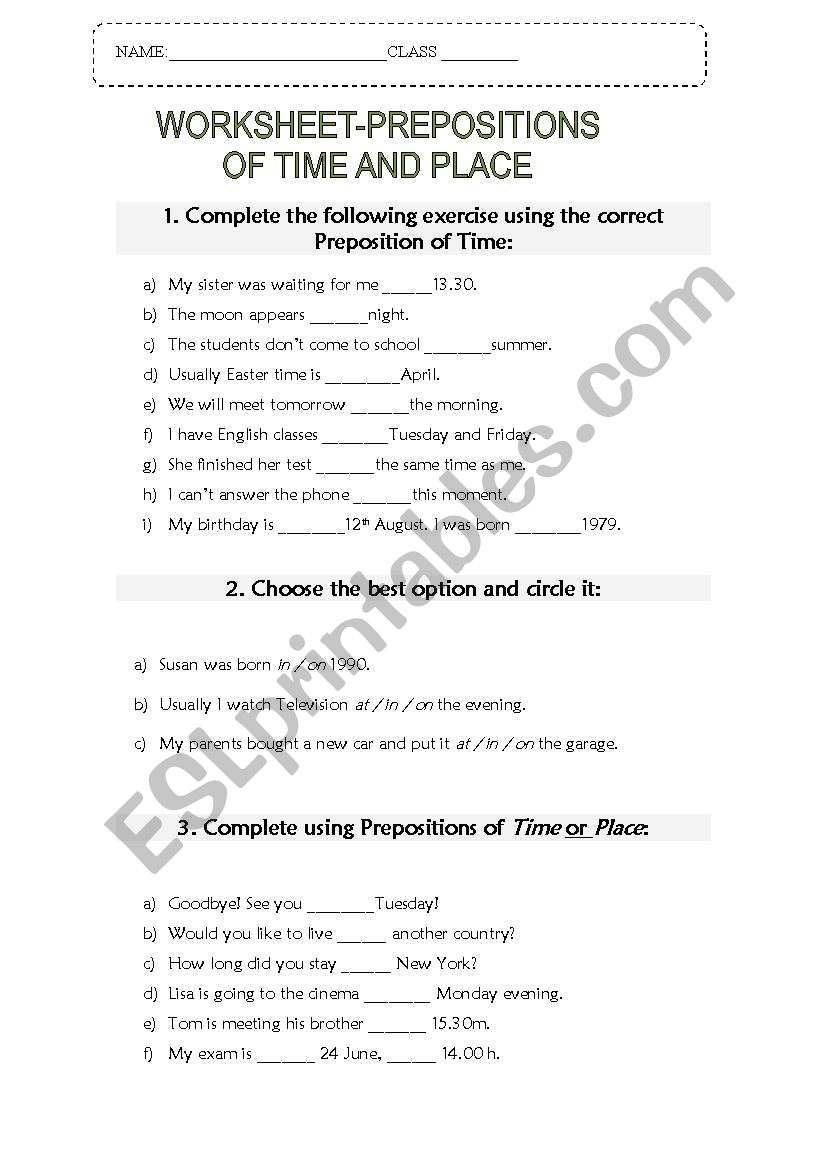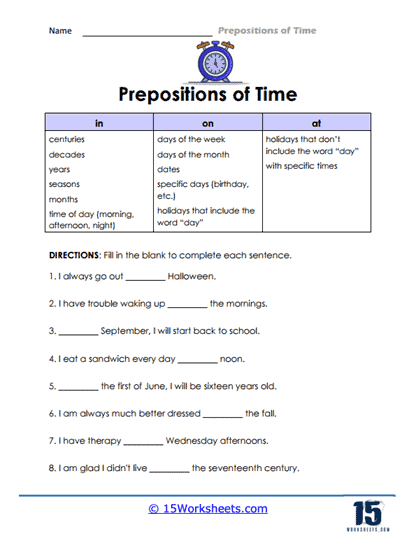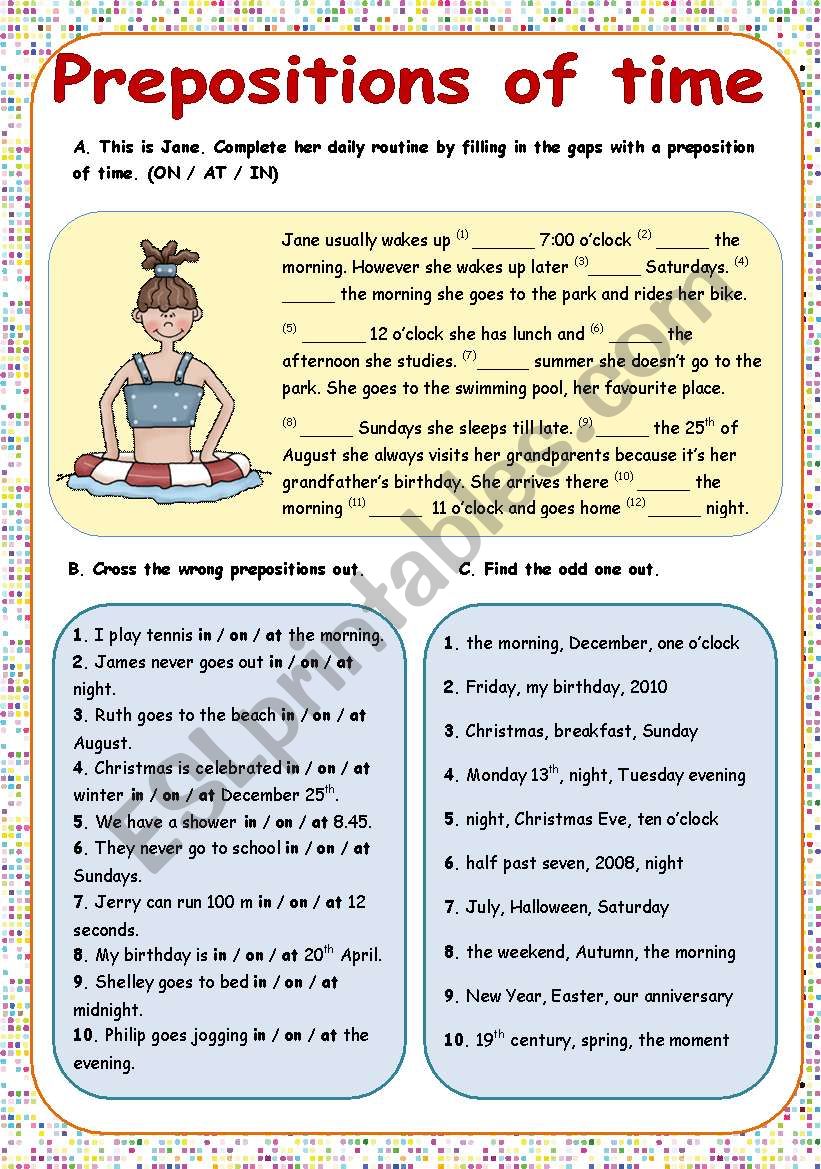
Mastering Temporal and Spatial Accuracy: The Indispensable Role of ESL Prepositions of Time and Place Worksheets
English prepositions are often described as small words that carry immense meaning. They are the linguistic glue that connects nouns, pronouns, and phrases to other words in a sentence, indicating relationships of time, place, direction, and more. For native speakers, their usage is largely intuitive, absorbed through years of exposure and practice. However, for English as a Second Language (ESL) learners, mastering prepositions presents one of the most persistent and perplexing challenges. Unlike verbs or nouns, prepositions often defy direct translation, possess multiple meanings depending on context, and are riddled with idiomatic expressions. This complexity makes targeted practice absolutely crucial, and the solution often lies in targeted, well-designed ESL prepositions of time and place worksheets.
These specialized worksheets are not merely supplementary materials; they are foundational tools in any comprehensive ESL curriculum. They provide the structured, repetitive, and contextualized practice necessary for learners to move beyond rote memorization to genuine understanding and accurate application. This article will delve into the intricacies of English prepositions of time and place, explore the common pitfalls ESL learners face, and elaborate on why ESL prepositions of time and place worksheets are an indispensable resource for achieving fluency and precision in English communication.
The Intricate Dance of Time and Place: A Prepositional Primer

Before discussing the worksheets themselves, it’s vital to understand the core concepts they aim to teach. Prepositions of time and place are among the most frequently used and therefore, the most important for ESL learners to master.

Prepositions of Time: When Did It Happen?

These prepositions answer the question "when?" and primarily include in, on, and at, though others like before, after, during, until, since, and for are also common. The ‘in, on, at’ trio often causes the most confusion due to their overlapping uses.

-
IN: Used for longer, less specific periods.
- Months: in July, in December
- Years: in 1999, in the 21st century
- Seasons: in summer, in winter
- Decades/Centuries: in the 1980s, in the Middle Ages
- Parts of the day (general): in the morning, in the afternoon, in the evening (but
at night) - Future periods: in three days, in a week



-
ON: Used for specific days and dates.
- Days of the week: on Monday, on Sunday
- Specific dates: on July 4th, on December 25th, 2024
- Specific days with parts of the day: on Monday morning, on Friday night
- Holidays with "day": on Christmas Day, on New Year’s Eve
-
AT: Used for very specific points in time.
- Specific times: at 3 o’clock, at midnight, at lunchtime
- Holidays (general): at Christmas, at Easter (when referring to the period, not just the specific day)
- The weekend: at the weekend (British English, American English often uses
on the weekend) - Night: at night


Prepositions of Place: Where Is It Located?
These prepositions answer the question "where?" and again, in, on, and at are the most fundamental, along with others like under, over, behind, in front of, between, among, next to, above, below, etc.
-
IN: Used for enclosed spaces, large areas, or within something.
- Containers/Enclosed Spaces: in the box, in the room, in the car, in my pocket
- Geographic Areas: in London, in France, in Asia, in the ocean
- Books/Magazines: in the book, in the newspaper
-
ON: Used for surfaces or positions on a line/route.
- Surfaces: on the table, on the wall, on the floor, on the roof
- Lines/Routes: on the street, on the road, on the map
- Public Transport: on the bus, on the train, on a plane (but
in a car/taxi) - Pages: on page 5
-
AT: Used for specific points, addresses, or general locations.
- Specific Addresses: at 123 Main Street
- Specific Points/Locations: at the bus stop, at the corner, at the door, at the airport
- Events/Activities: at the concert, at the party, at school, at work, at home (common idiomatic usage)
- Stores/Restaurants (general location): at the supermarket, at the restaurant
The ESL Learner’s Quandary: Why Prepositions Are So Hard
The challenges ESL learners face with prepositions are multifaceted:
- Lack of One-to-One Translation: Many languages do not have a direct equivalent for every English preposition. A single preposition in a learner’s native language might translate to several different English prepositions, or vice-versa, leading to confusion and errors.
- Multiple Meanings and Context Dependence: The same preposition can have vastly different meanings. "On" can mean ‘on a surface’ (on the table), ‘a specific day’ (on Tuesday), ‘connected to a device’ (on the phone), or ‘operating’ (the TV is on).
- Idiomatic Expressions: English is rich in fixed expressions and phrasal verbs that use prepositions in ways that defy logical rules (look up, break down, get along with). While this article focuses on time and place, the general challenge of prepositional idioms contributes to overall confusion.
- Subtlety of Distinction: The difference between
in,on, andatcan be very subtle, especially for place. Is it in the park or at the park? Both can be correct depending on context, making rule application difficult. - Native Speaker Intuition: Native speakers often "feel" which preposition is correct, a sense developed through immersion. ESL learners, lacking this intuition, rely on rules that are often inconsistent or have numerous exceptions.
Why ESL Prepositions of Time and Place Worksheets Are Essential Learning Tools
Given these challenges, the systematic and repeated exposure offered by well-designed worksheets becomes indispensable. ESL prepositions of time and place worksheets serve several critical pedagogical functions:
- Structured Practice: Worksheets break down the complex topic of prepositions into manageable, digestible units. Learners can focus on one preposition at a time, or compare a specific set (like
in, on, at) in a controlled environment. - Repetition and Reinforcement: Mastery of prepositions, like any linguistic element, requires repeated exposure and practice. Worksheets provide ample opportunities for this repetition, helping to solidify the rules and common usages in the learner’s memory.
- Contextual Learning: Effective worksheets present prepositions within meaningful sentences and scenarios, rather than as isolated words. This helps learners understand how prepositions function to convey specific relationships of time and place in real-world contexts.
- Variety of Exercise Types: Good worksheets offer a range of exercise formats to keep learners engaged and to address different learning styles. This might include:
- Fill-in-the-blank: The most common, reinforcing direct application of rules.
- Multiple choice: Helps differentiate between similar prepositions.
- Sentence completion: Encourages learners to construct their own sentences using target prepositions.
- Error correction: Develops a critical eye for common mistakes.
- Picture-based exercises: Particularly effective for prepositions of place, allowing visual learners to connect the word to a spatial relationship.
- Matching exercises: Connecting prepositions to their appropriate contexts.
- Immediate Feedback and Self-Correction: Many worksheets come with answer keys, allowing learners to check their work immediately. This instant feedback loop is crucial for reinforcing correct usage and correcting errors before they become ingrained habits.
- Diagnostic Tool: For teachers, worksheets can quickly highlight areas where students are struggling. Consistent errors on specific prepositions or types of usage can inform future lesson planning and targeted intervention.
- Self-Paced Learning: Worksheets allow learners to work at their own pace, reviewing concepts as needed and spending more time on areas they find particularly difficult. This autonomy can boost confidence and engagement.
Designing Effective ESL Prepositions of Time and Place Worksheets
Creating or selecting high-quality ESL prepositions of time and place worksheets involves careful consideration of several factors to maximize their effectiveness:
- Clear Instructions: Ensure instructions are simple, unambiguous, and perhaps provided in the learner’s native language if appropriate for beginners.
- Gradual Difficulty: Start with very basic, clear-cut examples and slowly introduce more complex sentences, exceptions, and idiomatic uses as the learner progresses. For instance, begin with "The book is the table" (on) before moving to "I saw her the concert" (at).
- Contextual Relevance: Use sentences and scenarios that are relatable to the learner’s daily life or general knowledge. Examples about school, work, hobbies, or common events make the learning more meaningful.
- Visual Aids: For prepositions of place, incorporating images, diagrams, or maps can significantly enhance understanding. A picture of a cat under a table or a clock showing a specific time can make the abstract concrete.
- Focus on Common Errors: Design exercises that specifically target the common mistakes learners make. For example, exercises that force a choice between
inandatfor locations, oronandatfor time. - Encourage Sentence Creation: Beyond fill-in-the-blank, include tasks where learners must create original sentences using given prepositions or describe pictures using prepositions of place. This pushes them beyond recognition to production.
- Include Answer Keys: For self-study or classroom use, a clear answer key is vital for self-correction and independent learning.
- Vary Exercise Types: Don’t stick to just one format. A mix of fill-in-the-blank, multiple choice, sentence rephrasing, and error correction will keep the learner engaged and test understanding in different ways.
- Reinforce Rules (Implicitly/Explicitly): While practice is key, a small rule box or reminder at the top of a worksheet can be very helpful, especially when introducing a new set of prepositions or clarifying distinctions.
Integrating Worksheets into a Holistic ESL Curriculum
While indispensable, worksheets should not be the sole method of instruction. Their power is maximized when integrated into a broader, communicative ESL curriculum.
- Pre-Worksheet Activities: Introduce the target prepositions through clear explanations, examples, and discussions before assigning worksheets. Use flashcards, realia, or miming to convey meaning.
- Post-Worksheet Activities: Follow up worksheet practice with communicative tasks.
- Speaking: Role-plays (e.g., giving directions using prepositions of place), describing daily routines (using prepositions of time), asking and answering questions.
- Writing: Journal entries, emails, short stories that naturally require the use of prepositions.
- Games: Board games, charades, or online interactive quizzes that reinforce preposition usage in a fun, low-pressure environment.
- Real-world Application: Encourage students to pay attention to preposition usage in authentic English materials like songs, movies, news articles, or everyday conversations.
Conclusion
The journey to mastering English prepositions, particularly those of time and place, is significantly aided by the consistent and thoughtful use of ESL prepositions of time and place worksheets. They address the unique challenges faced by non-native speakers by providing structured, repetitive, and contextualized practice. From distinguishing between the nuanced meanings of in, on, and at for both temporal and spatial contexts, to solidifying the application of other essential prepositions, these worksheets are the silent workhorses of prepositional mastery. By carefully designing and strategically integrating them into a dynamic ESL curriculum, educators can empower learners to navigate the complex world of English prepositions with greater confidence and accuracy, ultimately enhancing their overall communicative competence and fluency.
